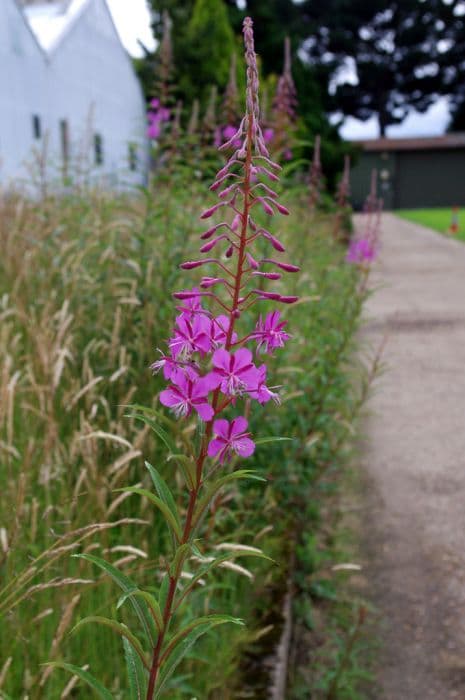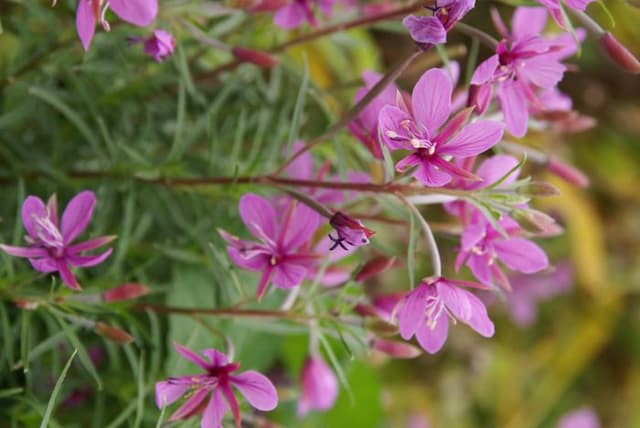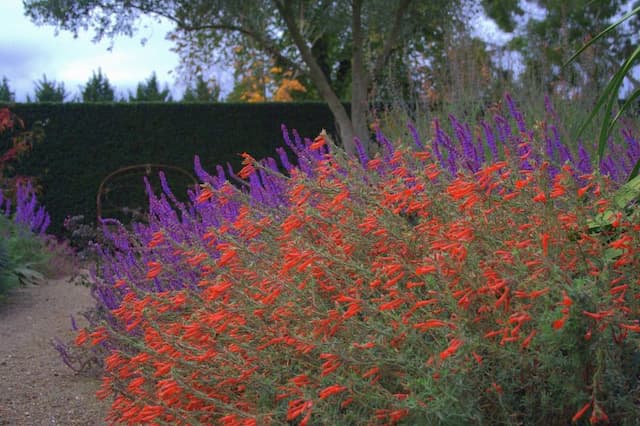Crown Imperial Oenothera Oenothera 'Crown Imperial'

ABOUT
The 'Crown Imperial' plant boasts a striking appearance with a multitude of unique attributes that capture the eye. Its stems are sturdy and often upright, supporting the weight of its lush, green foliage. The leaves adorn the stem with a pleasant green hue and exhibit a lance-like shape, which adds to the overall texture of the plant. The most remarkable features of the 'Crown Imperial' are its vibrant blooms. The flowers come in a diverse palette that may include shades of yellow, pink, white, or even a rich red, gracing the garden with a splash of color. These blossoms are typically large, bowl-shaped, and hang downward like bells from the upper part of the stem, giving it a regal, crown-like appearance, which is where it presumably gets its name. Each of these intricate flowers is composed of multiple petals that curve gracefully under, often revealing a delicate structure within. This plant is a striking addition to any garden, known not only for its visual appeal but also for the ambiance it creates. It emanates a presence that can be both bold and elegant, making it a favorite among garden enthusiasts who aim to add a touch of majesty to their outdoor spaces.
About this plant
 Names
NamesFamily
Onagraceae.
Synonyms
Crown Imperial Fritillary, Imperial Fritillary, Crown Imperial.
Common names
Oenothera 'Crown Imperial'
 Toxicity
ToxicityTo humans
There seems to be a mix-up in the name provided. Oenothera commonly known as evening primrose, and 'Crown Imperial' usually refers to a variety of Fritillaria imperialis. Both plants are generally not considered highly toxic to humans. However, members of the genus Fritillaria contain alkaloids that can cause mild stomach upset if ingested in large quantities. It is always a good practice to avoid eating any part of ornamental plants due to potential adverse effects.
To pets
Similar to the information provided to humans, it appears there is a mix-up in the plant name. Oenothera or evening primrose typically does not pose a significant risk to pets. On the other hand, 'Crown Imperial' refers to Fritillaria imperialis, which contains alkaloids that may cause mild digestive upset if pets consume large amounts. While serious poisoning is rare, pet owners should discourage their pets from eating ornamental plants.
 Characteristics
CharacteristicsLife cycle
Perennials
Foliage type
Deciduous
Color of leaves
Green
Flower color
Varies
Height
2-3 feet (0.6-0.9 meters)
Spread
1-2 feet (0.3-0.6 meters)
Plant type
Herb
Hardiness zones
5
Native area
North America
Benefits
 General Benefits
General Benefits- Attracts Pollinators: The plant is known to attract bees, butterflies, and other beneficial insects to the garden, which helps with the pollination of plants.
- Landscape Beautification: Adds a splash of color and visual interest to landscapes and gardens with its distinctive flowers.
- Drought Tolerance: Capable of withstanding periods of low water availability, making it suitable for xeriscaping or drought-prone areas.
- Easy Maintenance: Requires minimal care once established, making it a good choice for gardeners of all skill levels.
- Evening Bloom: The flowers of evening primrose often open in the evening, providing unique interest in the garden during later hours.
- Adaptability: Can thrive in a variety of soil types, although it prefers well-drained soils.
 Medical Properties
Medical PropertiesThis plant is not used for medical purposes.
 Air-purifying Qualities
Air-purifying QualitiesThis plant is not specifically known for air purifying qualities.
 Other Uses
Other Uses- Garden aesthetics: Crown Imperial is often planted for its showy and ornamental flowers, which can add an impressive display of color and height to garden borders or flower beds.
- Natural pest deterrent: The strong scent of the plant is thought to repel rodents and other garden pests, potentially protecting nearby plants.
- Cut flowers: The flowers of Crown Imperial can be used in cut flower arrangements, adding height and a unique, striking look to bouquets.
- Photography subject: Due to its dramatic blooms, the plant is a favorite subject for garden and plant photographers.
- Educational tool: The plant's unique morphology can be used as an educational example to teach about bulbous plant structure and growth patterns in botany classes.
- Companion planting: Crown Imperial can be planted alongside other spring bulbs to create layered garden designs due to its tall stature and early bloom time.
- Symbolism: In some cultures, Crown Imperial is used in gardens to symbolize power and majesty due to its crown-like appearance.
- Soil health indicator: The success or failure of the plant can serve as an indicator of the soil condition, such as drainage adequacy, for gardeners.
- Bee attraction: While it's not its primary purpose, Crown Imperial can attract bees when blooming, supporting pollinator populations.
- Seasonal garden planning: Its early spring flowering time can help gardeners plan succession planting, as other plants can take over when the Crown Imperial fades.
Interesting Facts
 Feng Shui
Feng ShuiThe Crown Imperial is not used in Feng Shui practice.
 Zodiac Sign Compitability
Zodiac Sign CompitabilityThe Crown Imperial is not used in astrology practice.
 Plant Symbolism
Plant Symbolism- Power and Authority: The 'Crown Imperial' name itself suggests regality and governance, as it invokes the image of a monarch's crown, symbolizing control and dominion.
- Pride: With its stately appearance and towering stems, the 'Crown Imperial' can represent pride and self-assurance, as it appears to stand tall and confident among other plants.
- Majesty and Splendor: The impressive and ornate blossoms of this plant signify grandeur and impressiveness, akin to the majestic presence of royalty.
- Strength and Resilience: The robust nature of the 'Crown Imperial' plant signifies fortitude and the ability to withstand adverse conditions.
 Water
WaterThe Crown Imperial, commonly known as Fritillaria imperialis, requires consistent moisture during the growing season but does not like to be waterlogged. It's best to water this plant once a week with about 1-2 gallons of water, ensuring that the soil is moist but allows for proper drainage. During the dormant period, after the plant has flowered and the leaves have died back, reduce watering significantly to prevent bulb rot. Allow the top inch of soil to dry out before watering again to encourage healthy growth.
 Light
LightFritillaria imperialis thrives in full sun to partial shade. It prefers to be planted in a location where it receives at least six hours of direct sunlight daily, as ample light encourages vigorous growth and optimal flowering. However, in very hot climates, afternoon shade can be beneficial to prevent the foliage from scorching.
 Temperature
TemperatureFritillaria imperialis, or Crown Imperial, performs best in temperate climates with temperatures ranging between 50°F and 70°F. It can survive winter temperatures down to about 20°F but requires a period of cold dormancy to thrive. The bulbs should be planted at a depth where they'll be insulated from extreme cold, ideally below the frost line.
 Pruning
PruningPruning of Fritillaria imperialis, or Crown Imperial, generally involves deadheading the spent flowers after blooming to encourage bulb strength. Additionally, remove any yellowed or withered leaves in late spring as the plant begins to go dormant. Pruning is not frequently required beyond this, and there's no set schedule—simply tidy up the plant as needed after flowering.
 Cleaning
CleaningAs needed
 Soil
SoilCrown Imperial thrives in well-draining soil that's rich in organic matter, ideally with a neutral to slightly acidic pH ranging from 6.0 to 7.0. A good mix could be composed of equal parts loam, peat, and sharp sand to ensure proper drainage and fertility.
 Repotting
RepottingCrown Imperials, being robust and larger perennials, do not require frequent repotting. They should be repotted only when they outgrow their current container, which may happen every 3 to 5 years.
 Humidity & Misting
Humidity & MistingCrown Imperial prefers outdoor conditions with average ambient humidity. It does not require high humidity levels and can tolerate the humidity found in most outdoor garden environments.
 Suitable locations
Suitable locationsIndoor
Provide bright light, well-draining soil, and keep at average room temperature.
Outdoor
Plant in well-drained soil, full sun, and protect from high winds.
Hardiness zone
5-9 USDA
 Life cycle
Life cycleFor the plant commonly known as 'Crown Imperial', the life cycle commences with seed germination, which requires a cold period to break dormancy, followed by warmer conditions for sprouting. This is succeeded by the seedling stage, where initial leaves and a root system develop, providing the young plant with nutrients. The vegetative stage follows, during which the plant undergoes rapid growth, producing a rosette of leaves and establishing a strong root system. Subsequently, the flowering stage occurs, typically in late spring to early summer, where tall spikes with yellow, pink, white or red flowers appear, attracting pollinators. After pollination and fertilization, the plant enters the fruiting stage, developing seed capsules that, upon maturity, release seeds to restart the life cycle. Eventually, the plant enters senescence, where growth slows, leaves wither, and it may die back, especially in colder climates, though it can behave as a perennial, regrowing from the rootstock the following season.
 Propogation
PropogationPropogation time
Late Winter - Early Spring
The most popular method of propagating the Evening Primrose 'Crown Imperial' is through its seeds. The optimal time for sowing seeds is late winter or early spring. To propagate, seeds should be spread over the surface of a well-draining soil mix and lightly covered with additional soil. They require light to germinate, so the soil should not be too dense. The tray or container must be kept at a steady temperature of around 70°F (approximately 21°C) and consistently moist. Germination can take anywhere from two to four weeks, after which seedlings should be thinned out or transplanted to individual pots once they are large enough to handle. This ensures that each plant has enough space to develop a strong root system before being moved to its final location in the garden.









